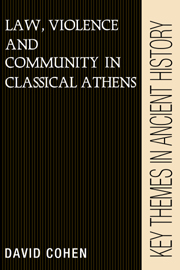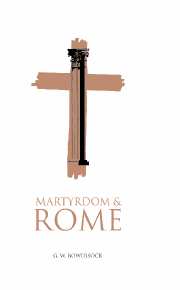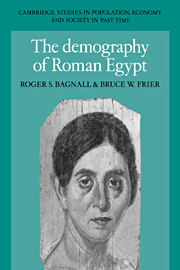Refine search
Actions for selected content:
23990 results in Ancient history
PART II - THE LEGAL SUBJECT
-
- Book:
- Law's Cosmos
- Published online:
- 07 September 2010
- Print publication:
- 07 January 2010, pp 113-114
-
- Chapter
- Export citation
Contents
-
- Book:
- Law's Cosmos
- Published online:
- 07 September 2010
- Print publication:
- 07 January 2010, pp vii-viii
-
- Chapter
- Export citation
2 - Legal violence and the limit of justice
- from PART I - THE BOUNDARIES OF LEGAL DISCOURSE
-
- Book:
- Law's Cosmos
- Published online:
- 07 September 2010
- Print publication:
- 07 January 2010, pp 66-112
-
- Chapter
- Export citation
Frontmatter
-
- Book:
- Law's Cosmos
- Published online:
- 07 September 2010
- Print publication:
- 07 January 2010, pp i-vi
-
- Chapter
- Export citation
PART III - TIME, MEMORY, REPRODUCTION: LAW'S PAST AND FUTURE
-
- Book:
- Law's Cosmos
- Published online:
- 07 September 2010
- Print publication:
- 07 January 2010, pp 199-200
-
- Chapter
- Export citation
General index
-
- Book:
- Law's Cosmos
- Published online:
- 07 September 2010
- Print publication:
- 07 January 2010, pp 354-362
-
- Chapter
- Export citation
4 - Logos biou: law's life stories
- from PART II - THE LEGAL SUBJECT
-
- Book:
- Law's Cosmos
- Published online:
- 07 September 2010
- Print publication:
- 07 January 2010, pp 155-198
-
- Chapter
- Export citation
3 - Legal fictions: subjects probable and improbable
- from PART II - THE LEGAL SUBJECT
-
- Book:
- Law's Cosmos
- Published online:
- 07 September 2010
- Print publication:
- 07 January 2010, pp 115-154
-
- Chapter
- Export citation
1 - The world of law: oratory and authority
- from PART I - THE BOUNDARIES OF LEGAL DISCOURSE
-
- Book:
- Law's Cosmos
- Published online:
- 07 September 2010
- Print publication:
- 07 January 2010, pp 21-65
-
- Chapter
- Export citation

Law, Violence, and Community in Classical Athens
-
- Published online:
- 06 January 2010
- Print publication:
- 05 October 1995

Sources for Ancient History
-
- Published online:
- 06 January 2010
- Print publication:
- 17 November 1983

Martyrdom and Rome
-
- Published online:
- 06 January 2010
- Print publication:
- 06 April 1995

The Demography of Roman Egypt
-
- Published online:
- 06 January 2010
- Print publication:
- 16 June 1994
II - The State
- from Part II - The Institutions of the Hasmonean State
-
- Book:
- The Hasmoneans and their State
- Published by:
- Jagiellonian University Press
- Published online:
- 05 September 2014
- Print publication:
- 31 December 2009, pp -
-
- Chapter
- Export citation
Part III - Society
-
- Book:
- The Hasmoneans and their State
- Published by:
- Jagiellonian University Press
- Published online:
- 05 September 2014
- Print publication:
- 31 December 2009, pp 165-166
-
- Chapter
- Export citation
2 - The Priesthood
- from I - The Ruler
-
- Book:
- The Hasmoneans and their State
- Published by:
- Jagiellonian University Press
- Published online:
- 05 September 2014
- Print publication:
- 31 December 2009, pp 107-111
-
- Chapter
- Export citation
The Hasmonean State
-
- Book:
- The Hasmoneans and their State
- Published by:
- Jagiellonian University Press
- Published online:
- 05 September 2014
- Print publication:
- 31 December 2009, pp 231-231
-
- Chapter
- Export citation
2 - The Hasmoneans and their Critics
- from Part III - Society
-
- Book:
- The Hasmoneans and their State
- Published by:
- Jagiellonian University Press
- Published online:
- 05 September 2014
- Print publication:
- 31 December 2009, pp 173-182
-
- Chapter
- Export citation
1 - Mattathias and Judah: In Defense of the Ancestors' Religion
- from Part I - Judea under the Hasmoneans (167–63 BCE)
-
- Book:
- The Hasmoneans and their State
- Published by:
- Jagiellonian University Press
- Published online:
- 05 September 2014
- Print publication:
- 31 December 2009, pp 13-41
-
- Chapter
- Export citation
3 - Social Attitudes Toward the Hasmoneans
- from Part III - Society
-
- Book:
- The Hasmoneans and their State
- Published by:
- Jagiellonian University Press
- Published online:
- 05 September 2014
- Print publication:
- 31 December 2009, pp 183-186
-
- Chapter
- Export citation
